
The President, volume 1287.1 m3 [Robert Van Pelt].
Walk in the sequoia woods at any time of year and you will say they are the most beautiful and majestic on earth. Beautiful and impressive contrasts meet you everywhere, the colors of tree and flower, rock and sky, light and shade, strength and frailty, endurance and evanescence—John Muir (1911).

Researcher Marie Antoine gives perspective to the fire scar at the base of the Abraham Lincoln Tree in Sequoia National Park [Steve Sillett, 2005.07].

Filling the fire scar at the base of the Agassiz Tree in Calaveras State Park is a virtual who's who of Sequoiadendron researchers, including Bob Van Pelt, Steve Sillett, Mike Taylor, Dwight Willard, and Wendell Flint. See the Bookstore for works by these authors [C.J. Earle, 1998.07.14].
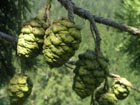
Cones in the top of an old tree at Whitaker Forest. The thick twig indicates that these cones have been here for many years, though they remain photosynthetically active [C.J. Earle, 2005.07.27].

Cones and foliage from the top of an old tree at Whitaker Forest [C.J. Earle, 2005.07.29].

Detail of foliage from the top of an old tree at Whitaker Forest [C.J. Earle, 2005.07.24].
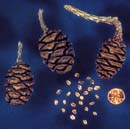
Seed cones and seeds [Dr. Linda B. Brubaker].
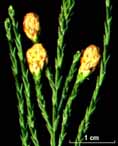
Foliage and pollen cones from an ornamental specimen [C.J. Earle, 1999.03].
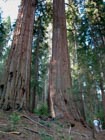
Two big trees in Whitaker Forest, both over 90 m tall, nicknamed "The Two Towers" (tree climbers, like mountaineers, are a bit obsessed with Tolkien). The best way to appreciate a Sequoiadendron is from a perch high in the crown [Anthony Ambrose, 2005.07].
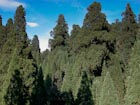
Mix of old trees, 80-90 m tall, and regeneration, 40-50 m tall, showing the difference in crown structure. Whitaker Forest [Marie Antoine, 2005.07].

The crown of a Sequoiadendron changes dramatically as it ages, from a simple cone of primary branches to a complex structure reflecting multiple episodes of epicormic branch formation, often recording damage from past episodes of drought, fire, and storm [Anthony Ambrose, 2005.07].
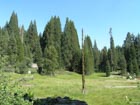
In the 1880's, the Big Stump Grove in Kings Canyon National Park became one of the few Sequoiadendron stands to be logged. The grove is now filled with fast-growing young Sequoiadendron trees [C.J. Earle, 2005.07.28].
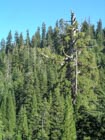
The Boole Tree, which is the largest tree now growing on lands owned by the U.S. Forest Service, was the sole survivor when the Converse Mountain grove was logged. It was felt sufficient to save the largest tree, while destroying the rest of the grove. The shock nearly killed the tree; all of its live branches died. Yet it resprouted epicormic branches and is regrowing its crown, just as the grove around it is regrowing as a forest of vigorous young Sequoiadendron [C.J. Earle, 2005.07.29].

Two ornamental trees in Ferndale, Washington. Although a dry site and hard-packed soil have restricted their growth, they still show the uniquely uniform conical crown that distinguishes young Sequoiadendron wherever they are planted [C.J. Earle, 2017.08.05].

The author doing some dendrochronological sampling in the crown of a giant sequoia [Cameron Williams, 2005.07.27].

U.S. stamp. Source: http://www.wood.co.jp/stamps/usa.htm, accessed 2001.12.25, now defunct).
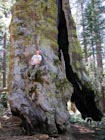
John Muir's stump; see "Remarks" for the story [Marie Antoine, 2005.07].
The venerable aboriginal sequoia, ancient of other days, keeps you at a distance, taking no notice of you, speaking only to the winds, thinking only of the sky, looking as strange in aspect and behavior among the neighboring trees as would the mastodon or hairy elephant among the homely bears and deer—John Muir
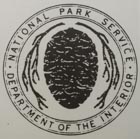
Until 1952, the U.S. National Park Service logo featured a Sequoiadendron cone (the current logo still features a Sequoiadendron) [C.J. Earle, 2018.06.01].
I bet you told her all your trees are sequoias—Grace Kelly in To Catch A Thief

Conservation Status

Sequoiadendron giganteum
(Lindley) J.Buchholz 1939
Common names
Giant sequoia, big tree, Sierra-redwood (Watson 1993), Wellingtonia [UK English]. Names in other languages are versions of these four names, e.g. Riesenmammutbaum [German], mammoetboom [Dutch], le Séquoia géant [French], secoya de Sierra [Spanish], веллингтония [Russian].
Taxonomic notes
The sole species in Sequoiadendron J.Buchholz 1939. Syn: Wellingtonia gigantea Lindley 1853; Sequoia gigantea (Lindley) Decaisne 1854, not Endlicher 1847. The latter homonym reflects the species' former inclusion in Sequoia, a conservative placement that still has merit (Watson 1993).
Although the giant sequoia was probably discovered in 1833 by the Walker party as they struggled through the Sierra north of the Yosemite valley, the species did not attract popular attention until its rediscovery in 1852, at what is now called the Calaveras North Grove (see this link for details). In the same year, specimens were received by Albert Kellogg of the California Academy of Sciences, who in May 1855 finally published it as Taxodium giganteum Kellogg and Behr. This was the fifth validly published name, however. The first name had been assigned on the basis of material collected (in the Calaveras grove) in summer 1853 by William Lobb, who was directed to the tree by Kellogg. Lobb dashed back to England, arriving 15 December 1853, and within two weeks the species was published by botanist John Lindley as Wellingtonia gigantea, named in honor of Arthur Wellesley, Duke of Wellington. In fact this name was already in use, Wellingtonia having been described in 1840 for a plant in the Sabiaceae, but this was not realized at the time. Lindley's publication triggered a storm of protest from American botanists who were outraged that the world's largest tree had been named for an English war hero by a botanist who had never seen the tree. The Americans promptly published a spate of different names, none of which are legitimate under current rules of botanical nomenclature. The French then intervened in the person of of Joseph Decaisne, who in 1854 published the species as Sequoia gigantea, a plausible assignment that ultimately won acceptance by British botanists. Thereafter Wellingtonia slowly disappeared from the literature. Unfortunately, Sequoia gigantea was also not a legitimate name, having been previously used by Endlicher to describe a horticultural variety of the coast redwood, and this problem was not satisfactorily resolved until the American John T. Buchholz described Sequoiadendron in 1939. Buchholz' decision to establish a new genus apart from Sequoia was widely criticized by the old guard of California botanists, but his arguments--based on substantial differences in the development of Sequoia and Sequoiadendron seed cones--have subsequently won general acceptance (Hartesveldt et al. 1975). For more on Buchholz and his work with Sequoiadendron see Schmid (2012).
The Save the Redwoods League (2017) has recently initiated an effort to fully sequence the Sequoiadendron genome.
Description
For the genus: "Trees giant, evergreen. Branchlets terete. Leaves alternate, radiating. Adult leaves mostly needlelike, triangular in cross section, somewhat divergent to strongly appressed; abaxial glands absent. Pollen cones with 12-20 sporophylls, each sporophyll with 2-5 pollen sacs. Seed cones maturing and opening in 2 years, persistent to 20 years, oblong; scales persistent, 25-45, valvate, ± peltate, thick and woody. Seeds 3-9 per scale, lenticular, subequally 2-winged; cotyledons (3-)4(-6). x = 11" (Watson 1993).
For the species: "Trees to 90 m; trunk to 11 m diam.; crown conic and monopodial when young, narrowed and somewhat rounded in age. Bark reddish brown, to ca. 60 cm thick, fibrous, ridged and furrowed. Branches generally horizontal to downward-sweeping with upturned ends. Leaves generally with stomates on both surfaces, the free portion to ca. 15 mm. Pollen cones nearly globose to ovoid, 4-8 mm. Seed cones 4-9 cm. Seeds 3-6 mm. 2n = 22" (Watson 1993). See García Esteban et al. (2004) for a detailed characterization of the wood anatomy.
Distribution and Ecology
USA: California: at 900-2700 m in mixed montane coniferous forests, in isolated groves along the western foothills of the Sierra Nevada (Watson 1993). The area of occupancy is 124 km2 (only 2% as large as Sequoia sempervirens), and each grove is very clearly delimited; there is no evidence that additional groves formerly occurred between the extant groves. Nearly all trees are distributed from the Kings River Canyon to near California Hot Springs, spanning 111 km north to south. Throughout this span, no more than 4 km separates any grove from the nearest neighboring grove. North of the Kings River, there are additionally eight widely-scattered groves, spanning 273 km from the Kings River north to near Lake Tahoe. These eight groves occupy only 1.1 km2; the smallest grove has only six trees and is 90 km from the nearest other grove (Van Pelt 2022; area of occupancy revised, Van Pelt email 2022.09.22). See also Thompson et al. (1999).
Distribution. Primary data from USGS (1999). This GIS data is very unreliable, however. Most of the groves are poorly located (by up to several kilometers) and many are not shown on other inventories. I have relocated some and added other groves as shown in notes for individual polygons. Principal sources for these edits include personal observations and the comprehensive inventory with maps compiled by Willard (2000). Click on each grove for more information.
As early as 1938, Buchholz noted that Sequoiadendron cones can live, remain green, and potentially shed viable seed for a period of decades. Evidently the cones initiate and mature on the common 2-year conifer cycle, but then rather than ripening and dying, they remain green and contain viable seed for many years. Some seeds are commonly released at infrequent intervals, but a severe stress event (such as a ground fire) can trigger release of all seeds. The precise physiological mechanism has not been determined. This phenomenon of retaining living green cones with viable seed for a period of decades has not been observed in any other conifer species.
A great deal of work has been done studying the role of fire in this ecosystem and the importance of maintaining an appropriate fire regime in Sequoiadendron forests; reviews are provided by Swetnam et al. (2009) and Van Wagtendonk and Fites-Kaufman (2006).
In the 1970's, the California Department of Forestry used Sequoiadendron to reforest certain burned areas in the San Jacinto, San Gabriel and San Bernardino Mountains of southern California. Schmid and Schmid (2012a, 2012b) report that the species has now naturalized in these areas, and is "regenerating prolifically" at the San Jacinto Mountains site. Naturalized populations are also known from Ireland, the U.K., and Turkey (GBIF 2022).
Although the giant sequoia has primarily attracted attention due to its extremely large size, recent studies (Sillett et al. 2000) have revealed that trees, like mountains, tend to become structurally complex when they grow very large. A canopy exploration of what was then the second-largest tree, the Washington tree in Giant Forest, found that the tree's canopy included 46 secondary trunks, and that the main trunk was hollow: a 35 meter deep, 2-3 meter wide pit extended into the trunk below an entrance 58 m above the ground. Alas, the Washington tree died when a prescribed fire went awry in 2002; the burnt trunk fell a few years later, and now nothing remains but a giant charred stump.
A few more bits of interesting data emerged when one of the largest living Sequoiadendron trees, the Robert E. Lee tree, was studied in detail during July of 2007 (in litt.). This one tree has approximately five times the living leaf biomoss of the largest Douglas-fir (Pseudotsuga menziesii) ever measured, and has approximately 2.8 billion living leaves.
Remarkable Specimens
Big and Tall Trees
This species is commonly called the "biggest tree in the world", and there is no real competition for that title (but see the following paragraph). The General Sherman tree is largest: height 83.6 m, dbh 825 cm, crown spread 33 m, stem volume, 1473.4 m3, located in Sequoia National Park, CA. The second largest stem volume is recorded for the General Grant tree in Kings Canyon National Park, CA, which is 885 cm dbh and 81.1 m tall. However, the largest dbh (898 cm) and the largest footprint (87.14 m2) are recorded for the Boole Tree in Kings Canyon National Park (Van Pelt 2001). The tallest known giant sequoia is a specimen 94.9 m tall, first measured August 1998 by Michael Taylor in the Redwood Mountain Grove, California. This species also gets very large when planted outside its native range, and some such specimens are now over 150 years old. One such tree, famous as the largest non-native tree in New Zealand, was 462 cm dbh and 45.40 m tall when measured on 2013.10.28 (New Zealand Tree Register, accessed 2020.12.10); this may be the largest specimen outside its native range. The tallest planted specimen, to my knowledge, is 64.95 m tall (as of December 2020), and grows near Eagle Point, Oregon (Mario Vaden, 2020.12.04, accessed 2020.12.10). A Sequoiadendron 57.8 m tall is the tallest tree in Austria (Monumental Trees 2022).
There are a few other trees that sometimes claim the title of "largest". First is the closely-related coast redwood, Sequoia sempervirens, which commonly grows taller than Sequoiadendron. Timber scaling data show at least one specimen of Sequoia sempervirens, logged in 1945, had a recorded stem volume of approximately 1540 m3 (Robert Van Pelt, e-mail, 1999.07.29), larger than any living Sequoiadendron; on the other hand, there are Sequoiadendron stumps still out there that seem to have come from trees larger than any now living. Also, the largest measured footprint and diameter of any tree belong to the Tule Tree, the superlative specimen of Taxodium mucronatum; however it is not a very tall tree, which limits its wood volume.
The giant sequoia is often called the largest living thing on earth. That superlative is basically valid, but is somewhat debatable for two reasons:
1. It is difficult to define "a single living thing" among a group (living things) where it is sometimes impossible to draw a clear line between the individual and the colony. For example, an entire mountainside may be covered with a stand of aspen trees (Populus tremuloides) that are genetically identical and physically connected with each other (i.e., a clone); such a stand could be called "a single living thing". Closer to home, taxonomically speaking, clumps of Sequoia sempervirens may also be composed of genetically identical stems; the largest of these so-called "castles" are among the most impressive trees anywhere. Even if we restrict the field to identifiable single individual organisms, there are individuals of Ficus religiosa reported from India and Southeast Asia that sprawl over areas of hectares; although a direct comparison has not been made, industrious searching might turn up an individual larger than any Sequoiadendron. At this time the largest documented Ficus that I have heard of, is a banyan (F. benghalensis) in Uttar Pradesh, India, that supposedly covers 2.1 ha (Robert Van Pelt, e-mail, 1999.07.29).
2. A large tree is not alive in the sense that an animal, a fungus, or an herb are alive. The foliage and the outer surface of the tree (technically, its inner bark, cambium and sapwood) are composed wholly or in part of living cells. However, the bark and most of the wood (xylem) are dead. In this sense a tree is similar to a coral -- we see the living skin of tissue over a dead framework that the tree has built up over the centuries of its growth. Most biologists overlook this point and treat the entire tree, living tissue and dead wood, as "live biomass." In practice, it is extremely difficult to measure how much of a tree is actually living tissue. As an indicator, though, my work with tree rings in Sequoiadendron generally has revealed sapwood thicknesses of about 10 cm in most of the canopy, and this represents the approximate thickness of living wood on the tree. In conclusion, the General Sherman tree has the largest stem volume and probably the largest total biomass of any known individual tree. However, a few colonial organisms, including a variety of plants and some fungi, may have greater cumulative living biomass.
Old Trees
Sequoiadendron also contains some of the oldest trees ever found. A specimen logged in the 1870's in Converse Basin was sampled by M. Hughes, R. Touchan, and E. Wright and has yielded a crossdated age of 3,266 years (RMTRR 2006). There are also ages of 3,220 years (specimen D-21) and 3,075 years (specimen D-23) collected by Andrew E. Douglass in 1919. These were stump counts (some of Douglass' samples are still in storage at the Laboratory of Tree-Ring Research; they weigh hundreds of pounds). Also, 3,033 years for specimen CMC3 collected by Swetnam and Baisan (Brown 1996). The only species (again, referring only to non-clonal individuals) known to attain greater ages are Pinus longaeva and Fitzroya cupressoides.
The lower photo at right shows a burnt stump in Sequoia National Park. John Muir once visited it, and in a story he tells in "The Mountains of California" (Muir 1894, chapter 8), cut away the char (which extends to the center of the stump) and counted over 4,000 growth rings. You can still see the stump, and the places where he cut the char away to do his count. This is the only place I know where John Muir left physical evidence of his time in the Sierras. Muir was in error, though; a later researcher determined that he had counted one series of rings twice, and the stump in fact has a record of about 3,000 years.
Ethnobotany
This species has played a pivotal role in the evolution of the American conservation movement, and continues to provoke strong emotions among most people who encounter it on its native range. Sequoiadendron only occurs in groves, so that every place it can be seen, it is found within the native mixed conifer forest as a unique, insular stand of gigantic trees. The stature of the trees, despite their occurrence within one of the world's most impressive mixed conifer forest, is literally awe-inspiring. The Sequoia is the only other tree on earth that can even be compared to a large grove of Sequoiadendron, for although a number of other species approach it in girth, none are in the same class in regard to size, or cover the landscape with such a profusion of large individuals, with the sole exception of Sequoia. The trees are so large that when first discovered in the 1850's, many people did not believe that they existed. One tree was killed and its its bark stripped, to be sent back east for display at a major exposition. It was called a hoax, concocted from the bark of many trees. Later an entire tree was cut and sent back for another exposition, and soon the trees became famous throughout America. One of the first cultural responses to this fame was a concerted effort to log all the trees. The wood is not very useful; its most common use was as fenceposts, matchsticks or shingles. However logging proceeded with abandon, and one of the finest of all groves, the gigantic (3,500 acre) Converse Basin grove, was almost entirely fed to the sawmills. The pioneering American conservationist John Muir spearheaded a public outcry at this destruction, which culminated on September 26, 1890 with the designation of Sequoia National Park, the second national park (after Yellowstone) ever to be set aside in the United States. Every year, millions of people from around the world come to California to view the groves of Sequoiadendron, and it stands with Sequoia as one of the flagship species of forest conservation in the United States.
The protection of all remaining Sequoiadendron groves was achieved when President Clinton designated Giant Sequoia National Monument on April 15, 2000. The Proclamation establishing the Monument recognizes, among other things, that "These giant sequoia groves and the surrounding forest provide an excellent opportunity to understand the consequences of different approaches to forest restoration. These forests need restoration to counteract the effects of a century of fire suppression and logging. Fire suppression has caused forests to become denser in many areas, with increased dominance of shade-tolerant species. Woody debris has accumulated, causing an unprecedented buildup of surface fuels. One of the most immediate consequences of these changes is an increased hazard of wildfires of a severity that was rarely encountered in pre-Euroamerican times. Outstanding opportunities exist for studying the consequences of different approaches to mitigating these conditions and restoring natural forest resilience."
Sequoiadendron is also an immensely popular and successful horticultural species, easy to care for and forming a beautiful landscape tree even at an early age. The species has been planted throughout Europe since 1853, and is an especially popular ornamental in Australia, New Zealand, the U.K., and the U.S. (Hartesveldt et al. 1975). Hardy to Zone 7 (cold hardiness limit between -17.7°C and -12.2°C) (Bannister and Neuner 2001).
Humans have put Sequoiadendron to one use that is not seen in any other tree, except a few Sequoia. We drive through them. Here is a brief history of drive-through trees; all data from Van Pelt (unpublished information transmitted 2022.09). Note that the number of drive-through trees is diminishing; even in such large trees, cutting a tunnel severely reduces the tree's structural strength, and most of the historic tunnel trees have subsequently fallen. No new tunnel trees are likely to be created, at least on public lands.
| | |
Tree | Remarks |
| Dead Giant | The very first tunnel tree was located in the Tuolumne Grove in Yosemite National Park. With the rising popularity of Yosemite, there was pressure to develop better access to the Valley from the urban centers of San Francisco and Sacramento. In 1874, the Big Oak Flat Road was completed which passed through the Tuolumne Grove of giant sequoias. By far the largest tree in the grove was dead, and to impress upon visitors just how big these trees were, the decision was made to cut a tunnel through the tree large enough for carriages to pass. The brothers David and James Lumsden cut the passageway, which was completed in 1878 and a branch of the road curved out to pass through the giant wooden archway. |
| Wawona Tree | The second tunnel tree was to become the most famous tunnel tree in the world. The Yosemite Stage and Turnpike Company had the idea to increase tourism to the Mariposa Grove by creating another tunnel tree. A large tree in the upper grove was chosen as it already had large fire scar on both sides of the tree. The tunnel was cut by the Scribner brothers and completed in 1881. The Wawona Tunnel tree became immensely popular and everyone wanted to take a photo driving through or standing in the tunnel. The Wawona tree fell during a severe snowstorm in 1969. See also Wikipedia. |
| Pioneer Cabin Tree | The tree, located in the Calaveras grove, was discovered by 1857, when it was noted that the trunk was broken about 150 feet off the ground, and the tree was hollow. It was named for a huge fire cave at the base that was as large as a pioneer cabin. The opening was enlarged in the early 1880's to make this the third drive-through tree; the intent was that it should be a tourist attraction to rival the very popular Wawona tree. Sometime between 1935 and 1947 it was closed to vehicles. The tree fell during a storm on January 8, 2017. See also Wikipedia. |
| California Tunnel Tree | The Wawona tree was so popular that a second tunnel tree was cut in the Mariposa Grove in 1895. Cars were allowed to drive through the tree until 1932, when the road was rerouted. The tree remains standing and open to pedestrians. |
| Tunnel Log | Located in Sequoia National Park, this giant sequoia fell across the road to Crescent Meadow in 1937 and the tunnel was cut the following year to allow cars to pass through. It is currently the only giant sequoia one can drive through. See also NPS. |
| | |
Redwood, including both Sequoiadendron giganteum and Sequoia sempervirens, is the state tree of California (Watson 1993).
Sequoiadendron has also proven immensely useful in dendrochronological research, being used to study problems in fire history, past climates, and plant physiology. The species attracted early attention by Douglass (1945a, 1945b, 1946, 1949, 1950a, 1950b, 1951a, 1951b; retrospective by McGraw 2003) and others. In a spectacular piece of work, Swetnam et al. (2009) have developed a 3,000-year fire history. I have (2005-2006) done some work that involved coring these trees at heights from DBH to 90 m above ground and looking at variations in ring width and stable isotope (C, O) ratios with height; results are summarized by Ambrose et al 2006.
Observations
Since the designation of Giant Sequoia National Monument in 2000, all wild Sequoiadendron groves are protected. Most of them are fairly easy to visit (in the past, tunnels were cut through some trees, allowing you to literally drive through the tree). Particularly impressive and accessible groves are found in Yosemite, Sequoia and Kings Canyon National Parks; of these the most popular, and among the largest, is the Giant Forest in Sequoia National Park (Hartesveldt et al. 1975). The President, shown here, can be seen on the Congress Trail in the Giant Forest. It was originally (in 1923) called the Harding Tree, an appellation that fell from popularity along with the late President.
Remarks
The genus is named for Sequoia, the generic name of coast redwood, and the Greek Δέντρο, tree (Watson 1993). The species was (apocryphally) discovered in what is now the North Grove at Calaveras State Park; this has since become the most-visited of all the groves, thanks to easy access (Flint 1987).
Citations
Ahuja, M.R. 2009. Genetic constitution and diversity in four narrow endemic redwoods from the family Cupressaceae. Euphytica 165:5-19.
Brown, P.M., Hughes, M.K., Baisan, C.H., Swetnam, T.W., Caprio, A.C. 1992. Giant sequoia ring-width chronologies from the central Sierra Nevada, California. Tree-Ring Bulletin 52:1-14.
Buchholz, J. 1939. The generic segregation of the Sequoias. American Journal of Botany 26:535-538.
Douglass, A.E. 1945a. Survey of sequoia studies. Tree-Ring Bulletin 11(4):26-32.
Douglass, A.E. 1945b. Survey of sequoia studies, II. Tree-Ring Bulletin 12(2):10-16.
Douglass, A.E. 1946. Sequoia survey-III: Miscellaneous notes. Tree-Ring Bulletin 13(1):5-8.
Douglass, A.E. 1949. A superior sequoia ring record. Tree-Ring Bulletin 16(1):2-6.
Douglass, A.E. 1950a. A superior sequoia ring record. II. A.D. 870-1209. Tree-Ring Bulletin 16(3):24.
Douglass, A.E. 1950b. A superior sequoia ring record. III. A.D. 360-886. Tree-Ring Bulletin 16(4):31-32.
Douglass, A.E. 1951a. A superior sequoia ring record. IV. 7 B.C. - A.D. 372. Tree-Ring Bulletin 17(3):23-24.
Douglass, A.E. 1951b. A superior sequoia ring record. V. 271 B.C. - 1 B.C. Tree-Ring Bulletin 17(4):31-32.
GBIF. 2022.11.02. Overview data from search for "Sequoiadendron giganteum (Lindl.) J.T.Buchholz" at GBIF.org.
McGraw, D.J. 2003. Andrew Ellicott Douglass and the giant sequoias in the founding of dendrochronology. Tree-Ring Research 59(1):21-27.
Save the Redwoods League. 2017. Redwood Genome Project. Available https://www.savetheredwoods.org/project/redwood-genome-project/, accessed 2017.10.04.
Schmid, Rudolf. 2012. John Theodore Buchholz (1888-1951) studying conifers in California, especially Sequoiadendron and Sequoia (Cupressaceae) in 1936. Aliso 30(1):5-17.
Schmid, Rudolf and Mena Schmid. 2012a. Naturalization of Sequoiadendron giganteum (Cupressaceae) in montane southern California. Botanical Electronic News #461, accessed 2013.01.06.
Schmid, Rudolf and Mena Schmid. 2012b. Sequoiadendron giganteum (Cupressaceae) at Lake Fulmor, Riverside County, California. Aliso 30(2):103-107.
Swetnam, T.W. 1993. Fire history and climate change in giant sequoia groves. Science 262: 885-889.
Swetnam, T. W., C. H. Baisan, A. C. Caprio, P. M. Brown, R. Touchan, R. S. Anderson, and D. J. Hallett. 2009. Multi-millennial fire history of the Giant Forest, Sequoia National Park, California, USA. Fire Ecology 5(3):120–150.
Van Pelt, Robert. 2022. Annual Summary of Permanent Research Plots in Old-Growth Giant Sequoia Forests as Part of the Redwoods and Climate Change Initiative (RCCI). Unpublished report.
Van Wagtendonk, J. W., and J. A. Fites-Kaufman. 2006. Sierra Nevada Bioregion. Pp. 264–294 in Fire in California’s Ecosystems, Sugihara, N. (ed.). University of California Press.
Willard, Dwight. 2000. A Guide to the Sequoia Groves of California. Yosemite National Park: Yosemite Association. 124pp.
See also
Aune, Philip S. (Tech. coord.). 1994. Proceedings of the symposium on giant sequoias: their place in the ecosystem and society; June 23-25, 1992, Visalia, CA. General Technical Report PSW-GTR-151. Albany, CA: Pacific Southwest Research Station, Forest Service, U.S. Department of Agriculture. 170p.
Bidwell, R. and S. Jensen. 1998. Tree-of-the-Month 2/98 (Giant sequoia). http://www.cof.orst.edu/cof/fr/outreach/treeomth/sequoia/index.htm, accessed 2002.06.22, now defunct.
Burns and Honkala (1990).
Elwes and Henry 1906-1913 at the Biodiversity Heritage Library (as Sequoia gigantea). This series of volumes, privately printed, provides some of the most engaging descriptions of conifers ever published. Although they only treat species cultivated in the U.K. and Ireland, and the taxonomy is a bit dated, still these accounts are thorough, treating such topics as species description, range, varieties, exceptionally old or tall specimens, remarkable trees, and cultivation. Despite being over a century old, they are generally accurate, and are illustrated with some remarkable photographs and lithographs.
Farjon (2005).
Kruska, Dennis. 1985. Sierra Nevada Big Trees: History of the Exhibitions
1850-1903. Dawsons Bookshop.
McFarlan, James W. 1949. A Guide to the Giant Sequoias of Yosemite National Park. Yosemite Nature Notes, Vol. 28, No. 6. The Yosemite Naturalist Division and the Yosemite Natural History Association, Inc. The entire book is available online; click HERE (accessed 2006.02.24).
McGraw, Donald J. 1982. The tree that crossed a continent. California History Summer issue, pp. 120-139.
Schwarz and Weide 1962.
Threatened Conifers of the World.

















